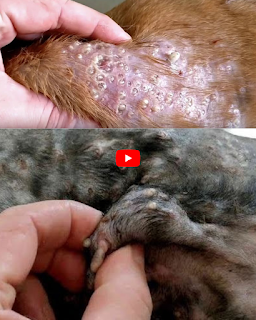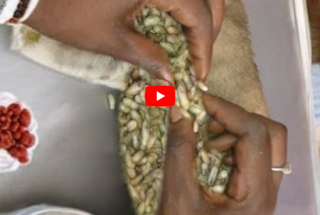Cordylobia anthropophaga and Its Effects on Dogs
Introduction
Cordylobia anthropophaga, commonly known as the African tumbu fly or mango fly, is a parasitic insect found mainly in tropical regions of Africa. It is infamous for causing myiasis—a condition where the larvae (maggots) infest and develop within the skin of mammals, including humans and dogs. Among domestic animals, dogs are particularly susceptible because of their outdoor habits and close contact with soil or contaminated environments. Understanding the life cycle, transmission, clinical signs, and treatment of Cordylobia anthropophaga infestations is crucial for veterinarians, pet owners, and anyone living or traveling in endemic regions.
Life Cycle and Transmission
The life cycle of Cordylobia anthropophaga involves four stages: egg, larva, pupa, and adult. The adult female fly lays her eggs on soil contaminated with feces or urine, or on damp clothing, bedding, or animal fur. The eggs hatch within one to three days, and the tiny larvae remain in the environment waiting for a host. When a dog lies on infested ground, the larvae penetrate the skin, usually through hair follicles or small abrasions.
Once inside, the larvae develop within the subcutaneous tissue, forming a small boil-like swelling called a warble. The larval stage lasts about 8–15 days, during which the maggot feeds on tissue fluids. After maturing, the larva exits the host to pupate in the soil. Adult flies emerge approximately 10 days later, ready to continue the cycle.
This process is rapid and efficient, allowing Cordylobia anthropophaga populations to thrive in warm, humid conditions typical of sub-Saharan Africa.
Affected Areas and Risk Factors
Dogs in rural or peri-urban areas of East, Central, and West Africa are most affected. However, increasing travel and pet relocation have led to sporadic cases being reported in non-endemic regions such as Europe, the Middle East, and North America, when infected dogs are imported.
Certain factors increase a dog’s risk of infestation:
- Outdoor sleeping habits (especially on bare soil)
- Poor sanitation and presence of animal waste
- Warm and humid weather
- Presence of stray or untreated animals in the area
Because the tumbu fly is highly adapted to human environments, even domestic pets that live close to people are not entirely safe.
Clinical Signs in Dogs
The main sign of Cordylobia anthropophaga infestation is cutaneous myiasis, which appears as one or more raised, painful nodules on the dog’s skin. Each nodule contains a single larva and has a small central pore through which the larva breathes. The lesions are often mistaken for abscesses, insect bites, or cysts.
Common clinical symptoms include:
- Localized swelling and redness
- Pain or sensitivity when the area is touched
- Discharge of serous or purulent fluid
- Visible movement of the larva beneath the skin
- Restlessness, licking, or biting at the affected site
- In severe infestations, fever, lethargy, and secondary bacterial infections
Commonly affected areas include the abdomen, groin, limbs, and back, especially places that come into contact with the ground when the dog lies down.
Diagnosis
Diagnosis is primarily clinical, based on observing the typical boil-like lesion with a central breathing hole. In some cases, veterinarians may perform:
- Microscopic examination of exuded larvae to confirm species
- Ultrasound or X-ray imaging to locate deeper larvae
- Bacterial culture if secondary infection is suspected
Identifying Cordylobia anthropophaga larvae is relatively straightforward: they are short, thick, and covered in tiny black spines that help them anchor to the host’s tissue.
Treatment
The main goal of treatment is to remove the larvae safely and prevent infection. Veterinary treatment typically includes:
- Manual Extraction:
The larva can be gently expressed from the lesion using sterile forceps, often after applying local anesthesia or topical petroleum jelly to block the breathing pore, which forces the larva to emerge for air. - Wound Care:
After removal, the wound is cleaned thoroughly with antiseptic solutions such as povidone-iodine or chlorhexidine to prevent bacterial infection. - Antibiotic Therapy:
In cases with multiple lesions or signs of secondary infection, systemic antibiotics may be prescribed. - Pain Management:
Analgesics or anti-inflammatory drugs help reduce discomfort and promote healing. - Supportive Care:
Keeping the dog in a clean, indoor environment prevents reinfestation and promotes recovery.
Prompt treatment usually results in full recovery within days, but neglected cases can lead to deeper infections, tissue necrosis, or scarring.
Prevention and Control
Prevention of Cordylobia anthropophaga infestation centers around environmental hygiene and protective measures:
- Keep dogs indoors or provide clean bedding elevated above ground level.
- Wash and iron pet bedding, towels, and clothing, especially if dried outdoors—heat kills fly eggs and larvae.
- Dispose of feces properly to avoid attracting flies.
- Use insect repellents or topical anti-parasitic medications containing permethrin (where safe for dogs).
- Regular grooming and skin checks help detect early signs of infestation.
In endemic areas, community-wide control measures, such as waste management and public education, are critical to reduce fly breeding sites.
Zoonotic Importance
Although Cordylobia anthropophaga mainly affects animals, humans can also become accidental hosts. Human cases often occur when clothes or towels are left to dry outdoors and later used without ironing. The same preventive principles—good hygiene and careful handling of fabrics—apply to people and pets alike.
Conclusion
Cordylobia anthropophaga poses a significant health risk to dogs in tropical regions, causing painful skin lesions and discomfort. While infestations are rarely life-threatening, they can lead to secondary infections and distress for both pets and owners. Preventive measures—clean environments, good hygiene, and vigilant pet care—remain the most effective defense. Increased awareness among veterinarians and travelers is essential to recognize and manage this parasitic threat promptly, ensuring the health and welfare of dogs worldwide.




